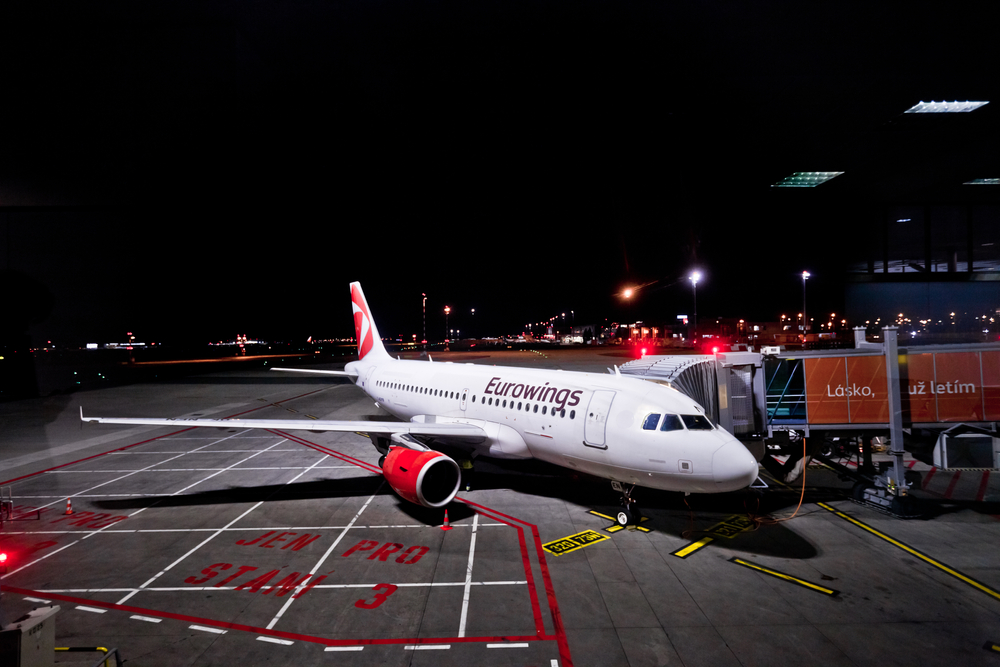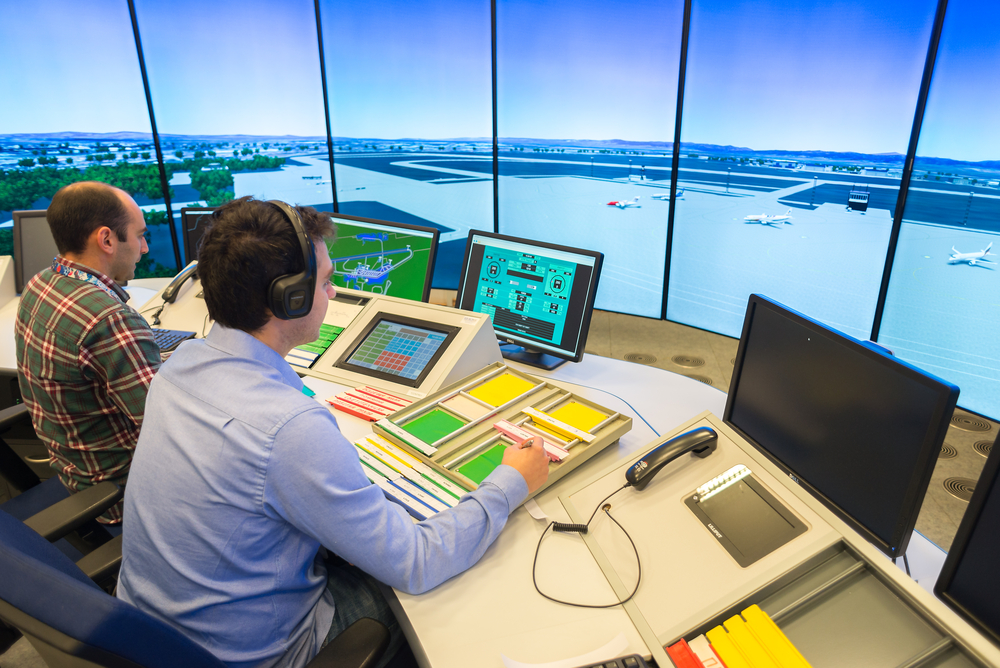Some of you may have never been to an airport. Chances are, those who have only accessed their terminals.
Airports comprise seven different structures: the runway, taxiway, terminal building, control tower, apron, hanger, and the airport parking lot for vehicles.

Each of these parts has a unique design and serves various purposes in the smooth running of air travel.
Let’s look at each of them in detail so that you know exactly where you are whenever you are in an airport.
Table of Contents
Runway
A runway is a special paved spot that airplanes use to land and take off. It is often on flat ground and free from obstructions such as tall buildings that may interfere with the pilots’ field of view.

Runways often resemble the usual tarmac roads but have special markings to tell them apart. After sunset, special lights light up the runway to help the pilots identify the landing spots.
These landing lanes are specially constructed depending on several factors. They should be constructed in the direction of the wind, not against it.
Additionally, a second runway is often placed normally alongside the primary runway for safety considerations.
Another factor influencing runways is traffic. If the airport is busy and movements exceed 30 per hour, a second runway should be considered.
Bitumen and concrete are the main materials considered when constructing a runway. While bitumen is economical, concrete has low maintenance costs and lasts for longer.
Because aircraft come in different sizes, the width of a runway depends on the type of aircraft utilizing it.
An average commercial airline runway length is between 8000 and 13000 feet. Also, the average width varies between 26 feet and 262 feet.
Other factors include temperature, land elevation, gradients, and take-off height.
Types of Runways

The following are different runway patterns available:
a) Single Runway
A single runway consists of a single lane of concrete constructed in the wind direction depending on the area.
The single runway is suitable for light traffic airports or airstrips that serve occasional use.
b) Two Runway
This is a double lane runway with the first lane meant for usual landing, while the second one comes in handy for safety purposes.
After studying the nature of the wind in that particular area, the constructors may construct the two runways in an X shape, T shape, or L shape.
c) Hexagonal Runway
This is a modern invention where the runway has at least six runways intersecting and laying close to each other.
This means that airplanes can land or take off at any time, provided the control tower has cleared them.
They are often suited to busiest airports or heavy traffic airports. A good example is the Berlin Tegel “Otto Lilienthal” Airport, which was located in Germany.
d) 45 Degree Runway

The 45-degree runway comes in handy when the wind coverage is greater than the airfield capacity. In simple terms, it is made up of 4 lanes.
e) 60 Degree Runway
Spotting this type of runway is easy because the runways seem to make a triangle. This is because some areas have winds coming from many directions.
It, therefore, becomes easier to design a runway facing every side of the wind so that the pilots have a choice during the crosswinds.
f) 60 Degree Parallel Runway
This is a more complicated version of the 60-degree runway. It is helpful when the wind coverage becomes greater in two directions forcing the operators to choose the third runway.
Apart from wind coverage, the 60-degree runway may experience more air traffic than the current runways can handle, making operations difficult.
This calls for an extra runway parallel to the main one hence the name 60 degree parallel runway.
Taxiway
When an airplane lands, it will have to move to other areas for storage and servicing after passengers disembark.

In other words, a taxiway is a path connecting the runway to other areas of the airport such as the hanger, apron, terminals, storage, and other facilities.
It is called a taxiway because the plane moves using its own power, and there are no speed limitations for taxiways.
Taxiways often have hard concrete or asphalt surfaces, especially for larger commercial airports.
Don’t be surprised to find grass or gravel taxiways in smaller general aviation airports.
Constructors lay the taxiways at a 30-degree angle to the runway in modern airports, making it easier for the plane to move from one runway to the other.
Note that the point where a runway and a taxiway meet should exceed one and half times the width of the taxiway
Apron
If you were just wondering where the airplane parking is or what is the name of the huge concrete space near a terminal building, it’s called an apron.

After spending long hours in the skies, the huge metal birds have to “rest.” After landing on a runway, the airplane will use the taxiway and finally find itself on the apron.
The apron is generally paved and situated in front of terminal buildings or next to hangers. For luggage planes, the apron acts as the loading and offloading area.
Aprons vary in size because the design is dictated by the number of planes expected at the airport and the physical designs.
Other factors considered include the suitability of the pavement slope and proper drainage facilities.
The apron should also be made in such a way that there is enough space for the incoming and outgoing planes to bypass each other.
Terminal Building
For those familiar with flying, most of everything you know or do at the airport revolves around the terminal buildings.
The terminal building is where most of the airports’ administration processes occur, such as the pre and post journey passenger checking.
The terminal building is an entry and exit point because passengers can board a plane directly using walkways and sky bridges connected to the terminal building.
People can also exit directly from the aircraft into the terminals. The terminal buildings also hold recreational areas such as cafes ad lounges while the passengers await their flight.

You can find facilities to transfer luggage, purchase a ticket and even go through security. If you carry illegal items or false documents, the airport security and the customs officers will be waiting for you right here.
Inside the terminals are unique structures known as concourses that the passengers pass through to access the aircraft via gates.
The word concourse can also mean terminal because the distinction largely relies on airport configuration.
The single terminal building will serve as a terminal and a concourse. Larger airports have several terminals, while smaller ones have a single one and no concourses.
For example, the Denver International Airport has a single terminal that connects to multiple concourses via tunnels, walkways, or sky-bridges.
Other larger airports have many terminals that also function as concourses, such as Dallas/ Fort Worth International Airport.
Functions of Passenger Terminals in Percentages
The passenger terminals play the following roles:
a) Traffic Function

The movement of passengers, goods, and equipment takes so much space that approximately half of the usable terminal building space is reserved just for this purpose.
Imagine crowds of outgoing and arrivals, loads of baggage, machinery, airport workers, and security and see why so much space is needed.
b) Commercial Function
This mainly refers to where cash, goods, and services change hands in a terminal building. The airline sale points, shops, cafes, and restaurants occupy between 5% and 10% of the usable area inside the terminals.
These percentages are dynamic and increase considerably in busy airports. Luckily, the revenue generated by the commercial function is enough to cover the extra surface area used.
c) Administrative Function
The administrative area houses the officials and governing bodies necessary for the operational management of the terminals.
These rooms and offices account for at least 10% to 15% of the total usable area. The administration services found here include:
1. Health
2. Weather
3. Government services such as border police and customs
4. Civil Aviation Service of Aerial Transport Police
d) Operational Function

Flight preparation offices for airlines and even transit assistance offices are found here. These services occupy an average of 19% of the terminal building area and are essential for the smooth running of the airport.
Sometimes, the control tower is located inside the terminals, especially for smaller airports.
e) Technical Function
The last 5% to 10% is reserved for technical operations. Several specialists look into smooth operation and maintenance of the actual buildings, and they too need some space.
This includes electricians, fire team, and even cleaning services.
Control Tower
The control tower is often the tallest building in an airport and the nerve of air travel. Qualified personnel use specific machines to give ground clearance, landing clearance, and in-flight information using advanced radar systems and communication through radios.
The main function of the control tower is airfield control which includes pre-flight, local, and ground control.
The control officer observes and communicates with other officials such as the weather department to give pilots informed decisions.
The controller informs the pilot about runway details, landing routes, airport traffic, wind speeds, and visibility before they attempt a landing.

Apart from offering approach control, the control tower can also provide an alerting service known as the Aerodrome Flight Information Service (AFIS).
Much care has to be taken when constructing a control tower because of the closeness, visibility, and other factors.
This means that the contractor has to study its functions and the purposes different workstations will serve in that control tower.
The size of the airfield is a major determiner of the location of the control tower. This is because certain posts such as the observation section must be strictly located inside the control tower.
Other lesser functions that don’t need a runway view can be positioned within adjacent buildings.
Functions of a control tower include flight information, approach control, management of apron traffic, alerting services, and marking control.
It also hosts the watch officers and runway offices.
Hanger
A hanger can be simply described as a repair garage for aircraft. Taxiways connect the runway to the hanger so that planes can easily move for maintenance.
Types of Hangers

a) Ordinary Hangers
An ordinary hanger is a large shed for aircraft maintenance made of frames and trusses. The idea has existed since the invention of heavier than air flights because the Wright brothers used to host their invention in a large shed.
Hangers are especially useful in airports with less traffic or in the private section since private aircraft travel less often.
The hanger will protect the plane against adverse weather conditions for extended periods, unlike the apron.
An ordinary hanger is also called a line or storage hangar. Ordinary hangers don’t have to be spacious or comfortable.
b) Maintenance Hangers
Maintenance hangers are much more complicated than their storage counterparts. They are designed uniquely with a different purpose in mind.
Maintenance hangars are wide open sheds whose only purpose is to house the plane and the servicepersons as they conduct major aircraft repairs.
Maintenance hangars are absent in most airports because they are insanely expensive. They don’t just house aircraft repairs; they also include test stands, tools, scaffolding, and maintenance stands.

You can also find component overhaul back shops with pneudraulic and hydraulic systems such as brakes and actuators.
As evidenced above, maintenance hangers conduct repairs that exceed base-level maintenance.
Repairs performed in ordinary airports include changing brakes and tires, repairing minor dents in the body, and other minor issues.
Parking
An airport parking lot is just a place to park your car, like in a school or inside the city. It is a paved section of the airport with several lanes meant for ordinary vehicle parking.
Passengers or airport staff can park their cars in special places under the terminals or next to the terminal buildings.
Types of Airport Parking Lots
a) Drop-off and Pick-up Zones
Vehicles dropping off passengers are parked here. Often, regular curbs can enter the airport and pick or drop people off for a period not exceeding 15 minutes.
b) Cell Phone Waiting Lots

If someone close to you is waiting to pick you up using their vehicles, they can utilize the cell phone waiting lots.
They are quite cheap, although remotely located.
c) Short-term Parking
This space is reserved for drivers who will spend a maximum of four hours inside the airport.
d) On-site Long-term Parking
If you drove yourself to the airport and intend to catch a flight for a few days, then this parking lot is for you.
The management knows that your trip will take a long time and therefore, they offer a discounted package.
However, on-site long-term parking spaces are not under airport management influence.
e) On-site Car Rental Parking
The basic airport business model of picking and dropping passengers has encountered major hurdles forcing those concerned to seek other sources of revenue.
One of them is the on-site car rental parking that houses companies that provide rental car services.

This is especially helpful if you are at the airport, need to rush somewhere urgently, and the other means of transport are not available.

















